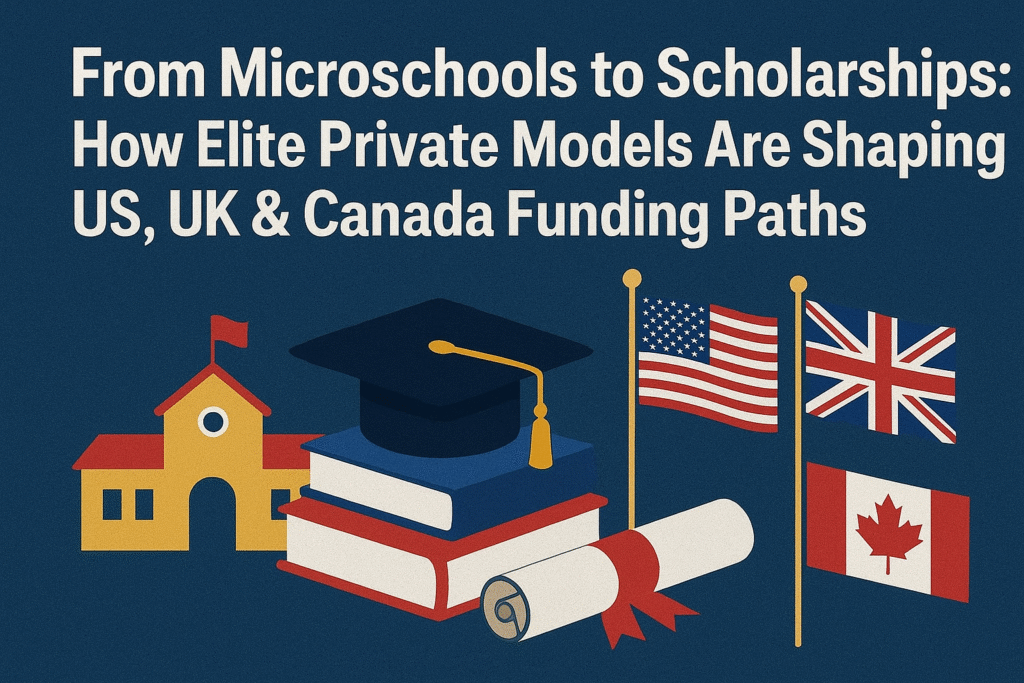The rise of microschools and the enduring power of elite private models are radically reshaping education funding. Discover how these trends are creating new scholarships pathways and influencing affordability in the US, UK, and Canada.
The Educational Crossroads
A quiet revolution is unfolding in education, one that challenges the very architecture of how we fund and deliver learning. On one side stands the centuries-old bastion of tradition: the elite private model, with its sprawling campuses, storied alumni networks, and stratospheric tuition fees. On the other emerges a nimble, modern disruptor: the microschool, a minimalist, hyper-personalized learning pod serving a handful of students.
Despite their apparent differences, these two models are not operating in separate universes. They are engaged in a complex dance of competition and convergence, and their interaction is fundamentally reshaping the landscape of educational funding and accessibility across the United States, the United Kingdom, and Canada. The pressure to demonstrate value, justify cost, and cultivate diverse student bodies is forcing a radical rethinking of the financial pathways to a quality education.
This article will explore this dynamic intersection. We will dissect how the innovative, often tech-driven funding mechanisms of microschools are pressuring established institutions to evolve. Conversely, we will examine how the powerful, endowment-backed scholarships and bursary programs of elite schools are adapting to new competition and societal demands for equity. The result is a fascinating transnational story of how the future of education funding is being written not by policymakers alone, but by the market forces of choice, innovation, and the relentless pursuit of talent.
The Disruptor – Deconstructing the Microschool Phenomenon
To understand their impact on funding, we must first define the microschool model.
What is a Microschool?
A microschool is a small, independent learning environment, typically serving 10-15 multi-age students. It is characterized by:
- Hyper-Personalization: Curriculum and pacing are tailored to each student’s needs, interests, and learning style.
- Blended Learning: A mix of direct teacher instruction, project-based learning, and online digital platforms.
- Agile Operation: Low overhead costs due to small physical footprints (often repurposed retail spaces, homes, or churches) and lean administrative staff.
- Mission-Driven: Often founded by educators or parents dissatisfied with traditional options, focused on specific pedagogical philosophies like Montessori, Reggio Emilia, or STEM/STEAM.
The Microschool Funding Model: Affordability and Innovation
Microschools have pioneered new financial pathways out of necessity.
- Lower Tuition: Without the burden of massive campus upkeep and large payrolls, tuition, while still significant, is often 30-50% less than that of a traditional elite private school.
- Hybrid Homeschool Co-ops: Many operate as co-ops, where parents contribute teaching time or administrative work in exchange for reduced fees, blending private education with a communal, cost-sharing approach.
- Voucher and ESA Utilization: In US states with school choice programs (e.g., Arizona, Florida, West Virginia), microschools are prime beneficiaries. They are designed to be funded by Education Savings Accounts (ESAs) or voucher amounts, making them a viable option for a broader range of families.
- ** Venture Capital and Philanthropy:** Some microschool networks (like Prenda or Acton Academy) have attracted investment to scale their models, while others are funded by philanthropic grants aimed at educational innovation.
This lean, accessible, and flexible funding approach is their primary disruptive force, putting pressure on all private education to justify its cost.
The Established Power – The Enduring Allure of the Elite Private Model
The elite private school—think Eton and Harrow in the UK, Phillips Exeter and Andover in the US, and Upper Canada College and St. George’s in Canada—remains a powerful force. Their value proposition is built on more than academics.
The Pillars of the Elite Model:
- Social and Cultural Capital: The network—the “old school tie”—is arguably as valuable as the education itself. Attendance provides lifelong access to a powerful alumni network.
- Unmatched Resources: State-of-the-art laboratories, Olympic-grade athletic facilities, world-class arts centers, and extensive libraries.
- Brand Prestige and University Placement: A long, documented history of placing graduates into top-tier universities worldwide.
- Highly Specialized Faculty: The ability to attract and retain teachers with advanced degrees and unique expertise.
The Traditional Funding Structure: The High-Tuition, High-Aid Model
For decades, these schools have operated on a simple principle: charge high tuition to those who can afford it and use a portion of that revenue to fund scholarships and bursaries for a select number of high-achieving, less-affluent students. This model:
- Subsidizes Need-Based Aid: Full-pay families effectively subsidize the education of those on financial aid.
- Relies on Endowments: Massive, billion-dollar endowments (especially in the US) generate investment income that is used to fund financial aid programs in perpetuity, insulating them from short-term enrollment fluctuations.
- Is Inherently Limited: There is a ceiling to how many students can be supported without jeopardizing the financial model or diluting the per-student resource advantage.
The Convergence – How Disruption is Forcing Evolution
The rise of viable, high-quality alternatives like microschools is forcing elite institutions to evolve their funding and value strategies.
1. The Pressure to Demonstrate ROI (Return on Investment):
Parents are increasingly asking: “Is this $50,000-a-year education worth it compared to a $20,000 microschool experience?” Elite schools can no longer rely on prestige alone. They are being forced to:
- Articulate Value: Better communicate outcomes beyond university acceptances, focusing on leadership development, character education, and specific skill acquisition.
- Innovate Pedagogically: Incorporate more project-based learning, personalized learning plans, and flexible spaces—hallmarks of the microschool model—to justify their premium.
2. The Expansion and Rebranding of Financial Aid:
The old “high-tuition, high-aid” model is being scrutinized for perpetuating a lack of socioeconomic diversity. In response, elite schools are launching ambitious, publicly visible campaigns.
- Need-Blind Admissions: A growing number of top US schools (thanks to their endowments) are adopting need-blind policies, meaning they admit students without regard to their ability to pay and then meet 100% of the demonstrated need. This is the gold standard for accessibility.
- Merit-Based Scholarships: While traditionally focused on need, schools are increasingly creating merit-based scholarships to attract specific talents—top STEM students, exceptional artists, or elite athletes—who might otherwise be lured by specialized programs or other institutions.
- First-Generation Programs: Targeted funding and support systems for students who are the first in their family to attend a private school or university.
3. The “Microschooling” of the Elite Model:
Some elite schools are adopting micro-esque features within their larger framework.
- House Systems (UK Influence): The classic British boarding school model, where a large school is broken down into smaller, competitive “houses,” provides a built-in micro-community, offering a sense of belonging and identity.
- Advisory Groups: Many schools are strengthening their advisory systems, creating small-group settings where a faculty mentor closely guides a group of 10-15 students throughout their entire secondary school career, mimicking the tight-knit adult-student ratio of a microschool.
A Transnational Comparison – US, UK, and Canada Funding Paths
The interplay between these models plays out differently across the three nations.
United States: The Free-Market Laboratory
- Dynamics: The US has the most vibrant and chaotic educational marketplace. A powerful tradition of elite private education coexists with the epicenter of the microschool and charter school movement.
- Funding Innovation: School choice is a powerful political force. Widespread ESAs and vouchers directly fund microschools, creating a viable, state-supported alternative to both public and traditional private schools. This forces elite schools to compete not just on prestige but on tangible value.
- Scholarship Scale: US elite schools, bolstered by the world’s largest endowments, offer the most generous financial aid programs globally, making them paradoxically more accessible to low-income geniuses than many mid-tier private schools.
United Kingdom: Tradition Under Pressure
- Dynamics: The UK system is deeply stratified, with the historic “public schools” (like Eton, Harrow) sitting at the apex. The microschool concept is less developed but growing, often framed as “alternative provision” or boutique tutoring centers.
- Funding Evolution: The pressure for change is more social than competitive. There is intense public and media scrutiny on the social exclusivity of elite schools. In response, they have massively expanded their bursary programs (need-based aid), with many aiming to become “needs-blind” for day students. They are fighting to justify their charitable status by proving a public benefit through accessibility.
- The “Scholarship” Meaning: In the UK context, a “scholarship” often remains a prestigious, merit-based award that offers honorific title and a small fee reduction (5-10%), not a full ride. The real financial support comes from means-tested “bursaries.”
Canada: The Middle Path
- Dynamics: Canada’s elite private schools are prestigious but generally less wealthy than their US counterparts. The microschool movement is emerging, particularly in major cities like Vancouver and Toronto, as a reaction to large class sizes in public systems.
- Funding Realities: Canadian schools lack the colossal US-style endowments. Their financial aid budgets are smaller, and “full-ride” scholarships are rare. Funding is more likely to be a partial bursary. This makes the affordability gap more acute and creates a significant opportunity for lower-cost microschools to capture the middle market of families seeking alternatives but priced out of the top tier.
The Future of Funding – Blended Models and the Democratization of Access
The future lies in hybridization and a broader definition of educational value.
- Partnerships, Not Just Competition: We may see elite private schools partner with microschool networks to offer specialized, alternative programs or to create feeder systems for nontraditional learners.
- Income-Share Agreements (ISAs): A funding innovation where a student agrees to pay a percentage of their future income for a set period instead of upfront tuition. This could be adopted by both innovative microschools and universities to which elite schools feed, reducing the financial risk of education.
- The Rise of the “Educational Wallet”: The success of ESAs in the US points to a future where education funding could be more portable, attached to the child, and usable across a spectrum of providers—from a coding boot camp to a microschool to a course at an elite private school. This would create a truly competitive market.
- Talent-Based Funding: Scholarships will become even more strategic tools for talent acquisition. Schools will use them to build a specific class profile, seeking not just the academically gifted but the artists, innovators, and entrepreneurs who will enhance the school’s brand and community.
Conclusion: The Redefinition of Educational Value
The rise of microschools is not a death knell for elite private education. Instead, it is a catalyst for its necessary and positive evolution. The competition between these models is driving a long-overdue focus on demonstrable value, pedagogical innovation, and, most importantly, genuine accessibility.
The ultimate winners in this transformation are students and families. They are gaining more choices than ever before. The pressure is now on every educational institution, from the century-old boarding school to the newest learning pod, to clearly answer the question: “What value do you provide, and is it worth the cost?” The pathways to funding that education—through disruptive new models, reformed scholarships, or state-supported choice—are multiplying. This fierce competition is finally forcing the world’s most traditional industry to innovate for the good of all learners, reshaping the educational landscape in the US, UK, and Canada for a new generation.


